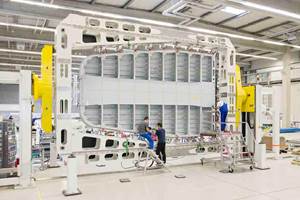We4Ce infused 2.5-3-MW rotor blade design passes validation test
Composite rotor blade structure design by We4Ce, mold and prototype production by InDutch Composites and fatigue testing by Suzlon Group has resulted in the novel blade’s IEC61400-5:2020 certification.
We4Ce's new blade design suspended in test rig. Source (All Images) | We4Ce
(Almelo, Netherlands), a Dutch rotor blade design and technology supplier, announced completion of end-to-end blade tests in India for a novel 2.5-3-megawatt (MW) rotor blade currently under development at a global wind blade manufacturer. After designing the blade structure in the Netherlands, partner (Gujarat, India) produced the mold for the prototype that wind turbine manufacturer (Pune, India) subsequently tested for load and fatigue. The results met IEC61400-5:2020 certification, the production standard for engineering integrity of wind turbine blades.
Eight months of design and engineering work preceded the rotor blade’s final validation testing. This included the blade’s structural design, the infusion process used for the materials — carbon fiber and epoxy resin — as well as training for the production of two molds and one complete rotor blade prototype. Passing these validation tests, the rotor blade is ready for serial production.
The standard IEC 61400-5:2020, issued by independent test service provider, TÜV Rheinland (Cologne, Germany), specifies the requirements for the engineering integrity of wind turbine blades and operational safety and includes aerodynamic, structural design and material selection. The certification provides the technical reference for designers and manufacturers among others.
“From an engineering perspective, this result is motivating,” says Arnold Timmer, managing director of We4Ce. “We had a very tight schedule of just eight months, which is a challenge, especially for the production of mold and prototype. In the end, successful TÜV certification proved that our engineering design will work in practice.”
Edo Kuipers, standing beside blade root bushing he designed.
We4Ce notes that its materials and methods differ from more traditional rotor blade development. “Unlike many others, we do not use pultrusion materials. In fact we consider these with some reservation, preferring to use infusion and a lower cost dry fabric-infused carbon fiber [for the spars],” explains Edo Kuipers, technology director and co-founder of We4Ce. Kuipers has spent the last 27 years in rotor blade design, founding We4Ce in 2008. “While pultrusion is a trending method, we believe it still needs to be proven long-term as it is costly and too technically risky without this long-term experience.” Kuipers points to infusion’s ability to offer uniform material distribution, thereby reducing the risk of cracks and delamination.
We4Ce is always considering its customer needs (blade manufacturers) to reduce/keep costs in check; its objective is to achieve a balance between costs and performance, including strength and aerodynamics. “We use infusion methods for our [carbon fiber spar] blade designs, and this enables our customers to use dry fabrics,” says Kuipers. “Our prescribed carbon fibers may cost as much as half of the carbon fiber that would be used in the pultrusion process, so that has huge cost-saving potential. We believe our method will offer endurance with minimum risk of technical problems 5-7 years down the line, which we believe is the point in time you can tell how good the original process was.”
Kuipers notes that infusion also works well for blade root inserts (the bushings that join the blade with the hub via bolts). In a 2.5-MW turbine design, We4Ce increased the root insert’s load-carrying capability by 20%.
For this project in particular, We4Ce trained technicians from Suzlon and InDutch Composites Technology to use its infusion method for prototype production. Carbon fibers and epoxy resin were placed in the mold and then vacuum processed for uniform distribution. Following prototype production, Suzlon performed static load tests, dual-axis fatigue and post-fatigue tests, simulating a 20-year lifecycle performance.
Offering full service from documentation, drawings, static to fatigue testing requirements, We4Ce supports training blade manufacturers worldwide during prototype blade production on-site. Currently, 40 customized rotor blade engineering designs have resulted, from 900-kilowatt, 23-meter-long blades to 14-MW, 108-meter-long blades.
Related Content
Revisiting the double vacuum debulk process
Evolution of the double vacuum debulk (DVD) process over the years continues to advance its “near autoclave quality” for low-void, highly compacted repair patches.
Read MoreClean Sky 2 outer wing box demonstrator validates OOA LRI, shimless assembly and SHM
Full-scale wing box project achieves TRL 5 with 2% weight reduction and 4% reduction in recurring production costs through improved manufacturing efficiency and assembly processes.
Read MoreFrom the CW Archives: Airbus A400M cargo door
The inaugural CW From the Archives revisits Sara Black’s 2007 story on out-of-autoclave infusion used to fabricate the massive composite upper cargo door for the Airbus A400M military airlifter.
Read MoreModular, curved racing track design enabled by composites and adaptive molds
X-Track worked with bespline to develop an easy-to-install, reusable, customizable composite sandwich panel alternative to dirt BMX and motorcross tracks.
Read MoreRead Next
Uavos OEM program enables high-efficiency CFRP rotor blades
Development of new all-composite helicopter retrofit blades with stainless steel leading edges highlights the company’s focus on greater operational efficiency and high resistance to harsh environments.
Read MoreSwancor, Adani sign MOU for recyclable wind farm in India
Joint development of a wind farm using wind blades made from Swancor’s EzCiclo recyclable epoxy resin will further support India’s 140-gigawatt wind capacity goal for 2030.
Read MoreNCC, BCI, Vestas collaborate to enhance wind blade technology development
NCC, BCI and Vestas have established the U.K. Offshore Wind Industrial Growth Plan, aiming to accelerate wind blade technology development and lower energy costs.
Read More












